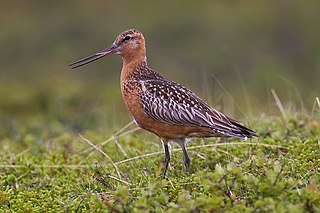
The bar-tailed godwit is a large wader in the family Scolopacidae, which feeds on bristle-worms and shellfish on coastal mudflats and estuaries. It has distinctive red breeding plumage, long legs, and a long upturned bill. Bar-tailed godwits breed on Arctic coasts and tundra from Scandinavia to Alaska, and overwinter on coasts in temperate and tropical regions of the Old World, Australia and New Zealand. The migration of the subspecies Limosa lapponica baueri across the Pacific Ocean from Alaska to New Zealand is the longest known non-stop flight of any bird, and also the longest journey without pausing to feed by any animal. The round-trip migration for this subspecies is over 29,000 km (18,020 mi).

The silver-ground carpet is a moth of the family Geometridae. The species was first described by Michael Denis and Ignaz Schiffermüller in 1775. It is common throughout the Palearctic region including the Near East and North Africa.

Johan Wilhelm Zetterstedt was a Swedish naturalist who worked mainly on Diptera and Hymenoptera.

Diapensia lapponica, the pincushion plant, is a plant in the family Diapensiaceae, the only circumboreal species in the genus Diapensia, the others being mainly in the Himalaya and on mountains in southwestern China. This species likely became circumboreal-circumpolar [Arctic–alpine] after it jumped to arctic habitat from North China and Russia. The most likely candidate for ancestor is a white-flowered D. purpurea The plants grow on exposed rocky ridges that are kept free from snow by high winds. Diapensia lapponica is extremely slow and low-growing and cannot compete with plants that overtop it. The plant is very sensitive to higher temperatures and so is often in misty foggy habitat. It usually dies when transplanted to lowland gardens and so this is not recommended. Cold-treated or wild and winter-collected seed will germinate indoors. The seed and leaves are high in lipids.

The Andrenidae are a large, nearly cosmopolitan family of solitary, ground-nesting bees. Most of the family's diversity is located in temperate or arid areas. It includes some enormous genera. One of the subfamilies, Oxaeinae, is so different in appearance that they were typically accorded family status, but careful phylogenetic analysis reveals them to be an offshoot within the Andrenidae, very close to the Andreninae.

Andrena, commonly called the mining bee, is the largest genus in the family Andrenidae, and is nearly worldwide in distribution, with the notable exceptions of Oceania and South America. With over 1,300 species, it is one of the largest of all bee genera. Species are often brown to black with whitish abdominal hair bands, though other colors are possible, most commonly reddish, but also including metallic blue or green.

Dactylorhiza lapponica, the Lapland marsh-orchid, is an orchid found in Scandinavia, Germany, Austria, Switzerland, France, Italy and the Czech Republic.

The bee subfamily Andreninae is a nearly cosmopolitan lineage, with most of its diversity in one genus, Andrena, which contains over 1500 species. The remaining four genera in the subfamily only contain a total of 9 species.
8441 Lapponica, provisional designation 4008 T-3, is a background asteroid from the Florian region of the inner asteroid belt, approximately 4.5 kilometers in diameter. It was discovered on 16 October 1977, by Ingrid and Cornelis van Houten at Leiden, and Tom Gehrels at Palomar Observatory in California. The L-type asteroid has a rotation period of 3.27 hours. It was named for the Bar-tailed godwit, a shorebird also known by its Latin name Limosa lapponica.

Flora Lapponica is an account of the plants of Lapland written by botanist, zoologist and naturalist Carl Linnaeus (1707-1788) following his expedition to Lapland.
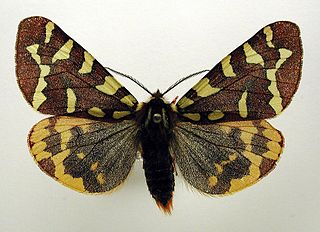
Pararctia lapponica is a moth of the family Erebidae first described by Carl Peter Thunberg in 1791. It is found in northern Eurasia and the Arctic part of North America.

Andrena scotica, the chocolate mining bee or hawthorn bee, is a species of mining bee from the family Andrenidae. It occurs in western Europe and is one of the most frequently encountered mining bees found in Great Britain, where it had been previously misidentified as Andrena carantonica.
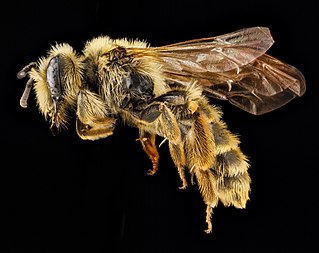
The death camas miner bee, is a species of miner bee in the family Andrenidae. Another common name for this species is death camas andrena. It is found in North America. It specialises in feeding on the highly poisonous Toxicoscordion venenosum and is possibly the only bee that can tolerate its toxins.
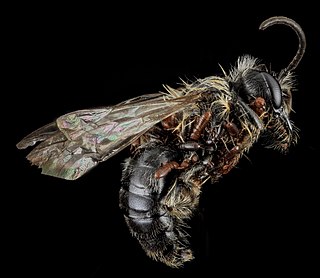
The Carlinville miner bee is a species of miner bee in the family Andrenidae. Another common name for this species is Carlin's miner. It is found in North America.
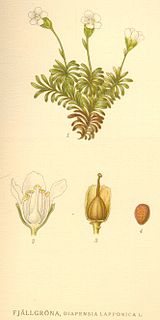
Diapensia is a genus of flowering plants of the family Diapensiaceae. Most of the species are found in the Himalaya. Diapensia lapponica has a high Arctic, circumpolar distribution.













